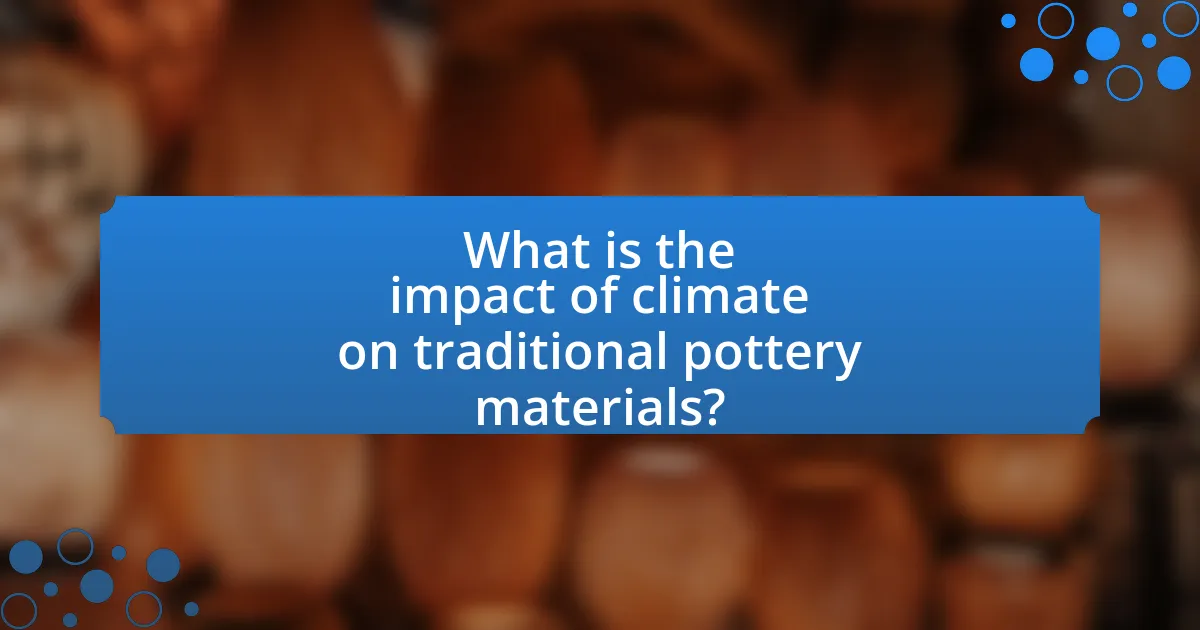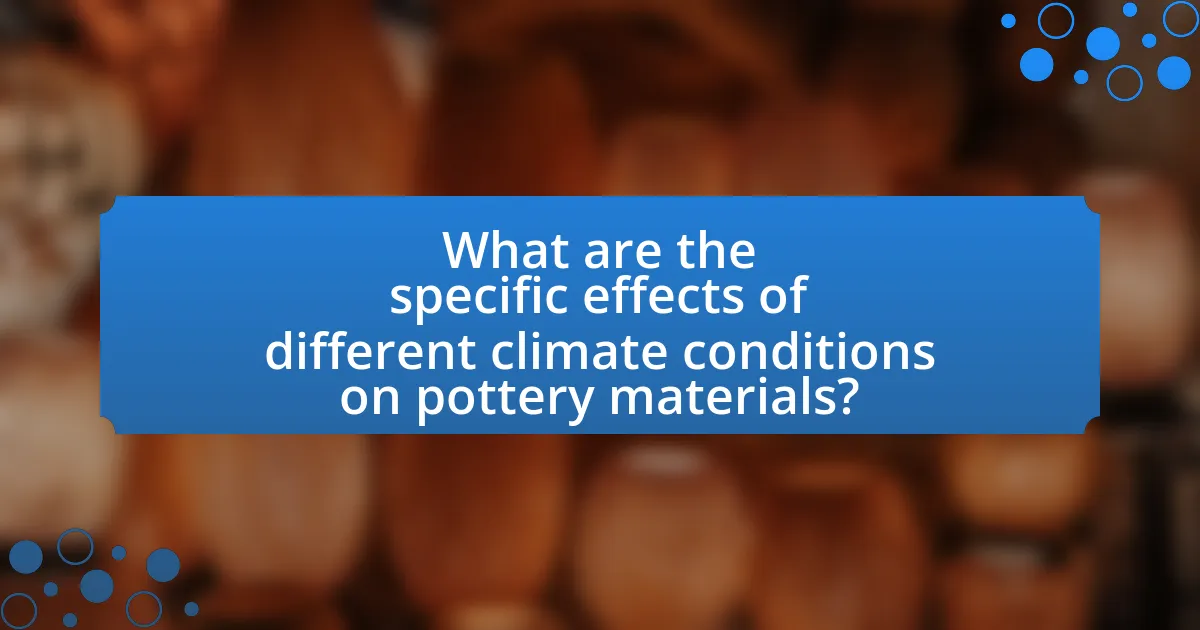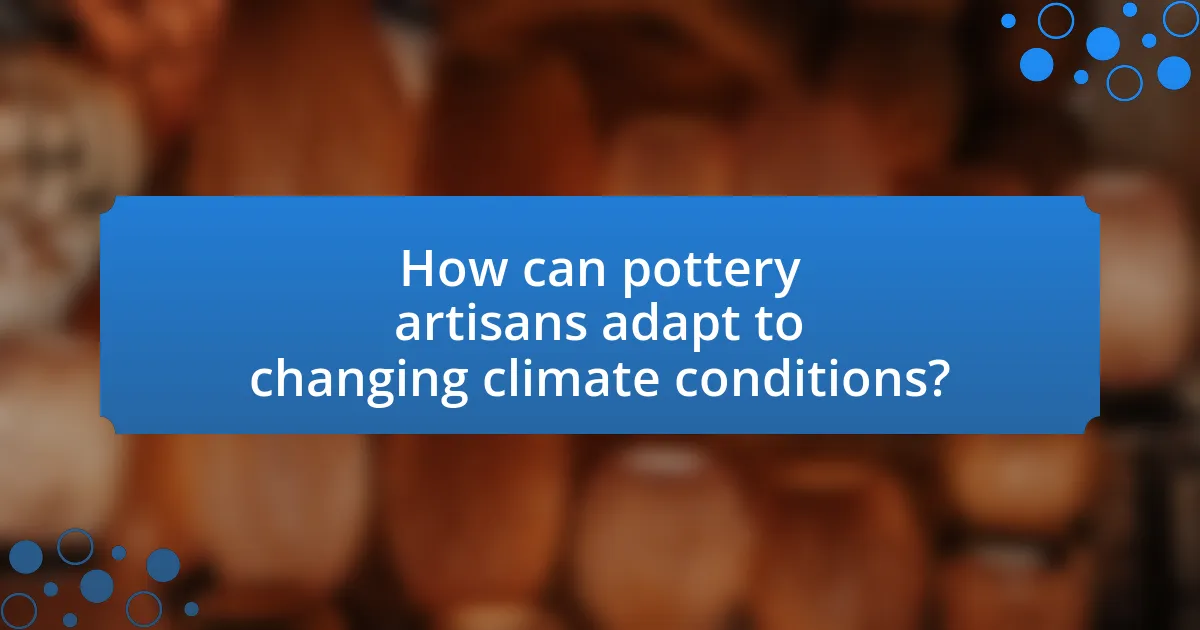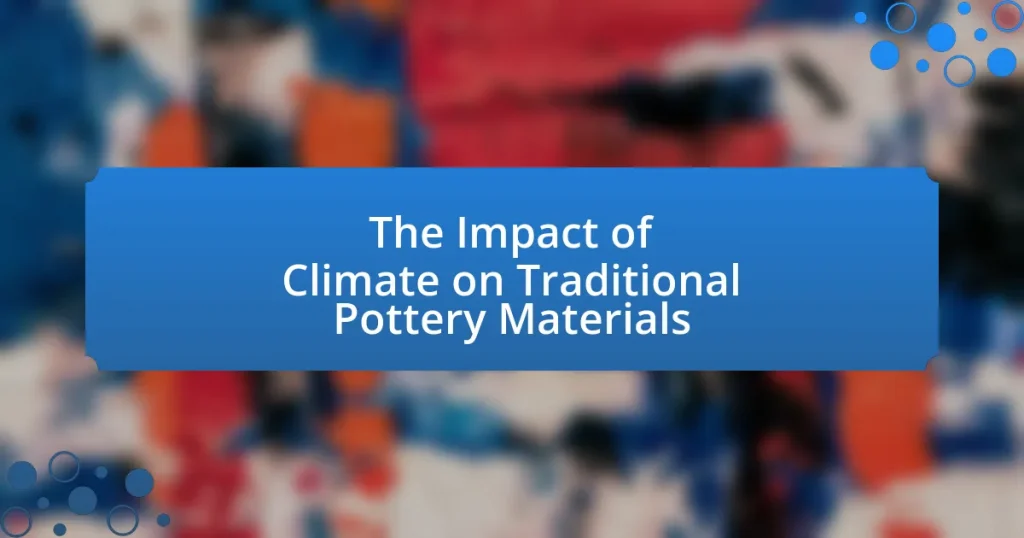The article examines the impact of climate on traditional pottery materials, highlighting how factors such as temperature, humidity, and precipitation influence the availability and properties of clay. It discusses the effects of different climate conditions on the workability, drying, and firing processes of pottery, as well as the cultural significance of these materials. Additionally, the article addresses the challenges posed by climate change to traditional pottery practices and explores adaptive techniques and resources available to artisans for mitigating these impacts. Understanding these dynamics is crucial for preserving the integrity and sustainability of traditional pottery in the face of changing environmental conditions.

What is the impact of climate on traditional pottery materials?
Climate significantly affects traditional pottery materials by influencing the availability and properties of clay, as well as the firing processes. For instance, high humidity can lead to increased plasticity in clay, making it easier to shape but also more prone to cracking during drying. Conversely, arid climates can cause clay to dry too quickly, resulting in warping or breakage. Additionally, temperature variations impact the firing process; higher temperatures can enhance the durability and strength of pottery, while lower temperatures may lead to incomplete vitrification, compromising the final product’s integrity. Historical evidence shows that regions with stable climates, such as the Mediterranean, produced more consistent pottery quality due to favorable conditions for both clay preparation and firing techniques.
How does climate influence the availability of raw materials for pottery?
Climate significantly influences the availability of raw materials for pottery by affecting the geological and environmental conditions necessary for their formation. For instance, regions with adequate rainfall and stable temperatures promote the weathering of rocks, which leads to the formation of clay deposits essential for pottery. Additionally, extreme weather conditions, such as droughts or excessive rainfall, can either deplete or enrich the soil, impacting the accessibility of clay and other minerals. Historical data shows that areas with consistent climate patterns, like the Mediterranean, have historically provided abundant clay resources, while regions experiencing climate variability may face challenges in sourcing these materials.
What specific raw materials are affected by climate conditions?
Clay, a primary raw material for traditional pottery, is significantly affected by climate conditions. Variations in temperature and precipitation can alter the moisture content and plasticity of clay, impacting its workability and firing properties. For instance, excessive rainfall can lead to clay becoming overly saturated, making it difficult to shape, while prolonged drought can dry out clay, causing it to crack. Additionally, the availability of specific clay types, such as earthenware or stoneware, can be influenced by climate, as geological processes are affected by long-term climate patterns.
How do temperature and precipitation levels impact material properties?
Temperature and precipitation levels significantly influence the properties of materials, particularly in traditional pottery. High temperatures can enhance the strength and durability of clay by promoting vitrification, a process where clay particles fuse together, resulting in a denser and more resilient product. Conversely, low temperatures can lead to incomplete firing, weakening the material. Precipitation levels affect the moisture content of clay; excessive moisture can lead to plasticity, making the clay easier to shape but also increasing the risk of cracking during drying. Conversely, insufficient moisture can cause the clay to become too dry and brittle, compromising its workability and structural integrity. Studies have shown that variations in these climatic factors can lead to significant differences in the final properties of pottery, impacting its usability and longevity.
Why is understanding climate’s impact on pottery materials important?
Understanding climate’s impact on pottery materials is important because it directly influences the availability, quality, and characteristics of the raw materials used in pottery production. For instance, variations in temperature and precipitation can affect the clay’s plasticity and firing properties, which are crucial for creating durable pottery. Research indicates that specific clay types, such as earthenware, stoneware, and porcelain, respond differently to climatic conditions, impacting their workability and final product strength. Additionally, historical data shows that shifts in climate have historically led to changes in pottery styles and techniques, as artisans adapt to the materials available in their environment.
What cultural significance do traditional pottery materials hold?
Traditional pottery materials hold significant cultural value as they reflect the identity, history, and artistic expression of communities. These materials, often sourced locally, embody the traditions and techniques passed down through generations, showcasing the unique characteristics of the region’s climate and environment. For instance, the use of specific clay types can indicate the geographical and cultural context of a community, as seen in the distinct pottery styles of the Pueblo peoples in the Southwestern United States, where the local clay is integral to their cultural heritage. Additionally, traditional pottery often serves functional purposes in daily life, reinforcing social practices and rituals, thus solidifying its role in cultural continuity.
How does climate change threaten traditional pottery practices?
Climate change threatens traditional pottery practices primarily by altering the availability and quality of essential raw materials, such as clay and water. Increased temperatures and changing precipitation patterns can lead to droughts, which reduce water supply necessary for shaping and firing pottery. Additionally, climate change can cause soil erosion and degradation, impacting the clay deposits that potters rely on. For instance, studies have shown that regions traditionally known for their clay sources are experiencing shifts in soil composition and moisture levels, making it more difficult for artisans to obtain the materials needed for their craft. This disruption not only affects the production process but also threatens the cultural heritage associated with traditional pottery practices.

What are the specific effects of different climate conditions on pottery materials?
Different climate conditions significantly affect pottery materials by influencing their drying, firing, and durability properties. For instance, high humidity can slow down the drying process of clay, leading to warping or cracking, while arid conditions can cause rapid drying, increasing the risk of surface defects. Temperature variations during firing can also impact the vitrification process, where insufficient heat may result in porous and weak pottery, while excessive heat can lead to over-firing, causing deformation. Additionally, exposure to extreme weather conditions, such as freeze-thaw cycles, can weaken pottery materials, making them more susceptible to breakage. Historical evidence shows that traditional pottery techniques often adapted to local climate conditions, demonstrating the direct relationship between climate and pottery material performance.
How does temperature variation affect pottery materials?
Temperature variation significantly affects pottery materials by influencing their physical and chemical properties during the firing process. When pottery is subjected to different temperatures, it can lead to changes in shrinkage, porosity, and strength. For instance, higher firing temperatures typically result in denser and stronger ceramics due to the vitrification process, where minerals in the clay melt and fuse together. Conversely, lower temperatures may not achieve full vitrification, leading to more porous and weaker pottery. Research indicates that specific clay types respond differently to temperature changes; for example, stoneware clays can withstand higher temperatures compared to earthenware clays, which are more sensitive to thermal fluctuations. This relationship between temperature and pottery materials is crucial for artisans to achieve desired characteristics in their finished products.
What are the effects of extreme heat on clay properties?
Extreme heat significantly alters clay properties by causing changes in its physical and chemical structure. When exposed to high temperatures, clay undergoes processes such as dehydration, which leads to the loss of water content and results in shrinkage. This shrinkage can cause cracks and warping in the clay body. Additionally, extreme heat can induce vitrification, where clay particles fuse together, enhancing strength and durability but also reducing porosity. Research indicates that temperatures above 1000 degrees Celsius can lead to these transformations, impacting the final characteristics of pottery.
How does cold weather influence the drying and firing processes?
Cold weather significantly slows down the drying and firing processes in pottery. The lower temperatures reduce the rate of evaporation of moisture from clay, leading to extended drying times. Additionally, during firing, cold conditions can affect the kiln’s temperature stability, making it harder to reach and maintain the necessary temperatures for proper vitrification and strength development in the pottery. Studies have shown that optimal drying and firing temperatures are crucial for achieving desired material properties, and deviations caused by cold weather can result in defects such as cracking or incomplete firing.
What role does humidity play in the pottery-making process?
Humidity significantly affects the pottery-making process by influencing the moisture content of clay, which is crucial for shaping and drying. High humidity can prevent clay from drying properly, leading to issues such as warping or cracking during the drying phase. Conversely, low humidity can cause clay to dry too quickly, resulting in similar defects. Studies have shown that optimal humidity levels, typically around 40-60%, allow for better workability of clay and reduce the risk of defects in the final product. This relationship between humidity and clay behavior is essential for potters to achieve desired results in their work.
How does high humidity affect the workability of clay?
High humidity enhances the workability of clay by increasing its plasticity and reducing the risk of cracking during shaping. When clay is exposed to high humidity, moisture is absorbed, which allows the particles to slide more easily against each other, making the material more malleable. This phenomenon is supported by the fact that traditional pottery techniques often rely on optimal moisture levels to achieve desired forms without compromising structural integrity.
What challenges does low humidity present for pottery artisans?
Low humidity presents significant challenges for pottery artisans, primarily by causing rapid drying of clay. This rapid drying can lead to cracking and warping of the pottery before it is fired, compromising the integrity of the final product. Additionally, low humidity can hinder the workability of clay, making it less pliable and more difficult to shape. As a result, artisans may struggle to achieve the desired forms and details in their work. The National Council on Education for the Ceramic Arts notes that maintaining optimal moisture levels is crucial for successful pottery production, highlighting the importance of humidity control in the crafting process.

How can pottery artisans adapt to changing climate conditions?
Pottery artisans can adapt to changing climate conditions by utilizing more resilient materials and modifying their production techniques. For instance, they can incorporate clay types that are less sensitive to temperature fluctuations and moisture levels, such as stoneware or porcelain, which can withstand extreme conditions better than traditional earthenware. Additionally, artisans can implement controlled drying and firing processes to mitigate the effects of humidity and temperature changes, ensuring consistent quality in their products. Research indicates that adapting to local climate conditions can enhance the durability and functionality of pottery, as seen in regions where artisans have successfully transitioned to using locally sourced materials that are more suited to their environment.
What techniques can be employed to mitigate climate impacts on pottery materials?
Techniques to mitigate climate impacts on pottery materials include the use of temperature-resistant clay bodies, the incorporation of sustainable materials, and the implementation of controlled firing processes. Temperature-resistant clay bodies can withstand extreme weather conditions, reducing the risk of cracking or deformation. Sustainable materials, such as recycled glass or natural additives, enhance the durability and environmental footprint of pottery. Controlled firing processes, including the use of energy-efficient kilns, minimize emissions and ensure consistent quality, thereby addressing the adverse effects of climate variability on pottery production.
How can artisans select alternative materials based on climate conditions?
Artisans can select alternative materials based on climate conditions by assessing the local environment and identifying materials that offer durability and functionality in specific weather patterns. For instance, in humid climates, artisans may choose materials that resist moisture absorption, such as certain types of clay or synthetic composites, to prevent degradation. Conversely, in arid regions, they might opt for materials that can withstand extreme heat and dryness, like heat-resistant ceramics. Research indicates that the choice of materials directly influences the longevity and performance of pottery, as seen in studies highlighting the use of local resources that align with climatic challenges, such as the adaptation of terracotta in Mediterranean climates to enhance resilience against moisture.
What innovative practices can be adopted to enhance resilience?
Innovative practices that can be adopted to enhance resilience in traditional pottery materials include the use of sustainable sourcing techniques, the incorporation of climate-adaptive materials, and the implementation of advanced firing technologies. Sustainable sourcing techniques, such as utilizing locally available clay and natural additives, reduce environmental impact and ensure material availability despite climate fluctuations. Incorporating climate-adaptive materials, like bio-based polymers or recycled materials, can improve the durability and performance of pottery against extreme weather conditions. Advanced firing technologies, such as low-energy kilns or solar-powered options, minimize energy consumption and carbon emissions, contributing to a more resilient production process. These practices are supported by research indicating that sustainable methods can significantly reduce the vulnerability of traditional crafts to climate change impacts.
What resources are available for pottery artisans facing climate challenges?
Pottery artisans facing climate challenges can access various resources, including grants, educational programs, and community support networks. Organizations such as the Craft Emergency Relief Fund provide financial assistance to artisans affected by climate-related disasters. Additionally, workshops and online courses offered by institutions like the American Craft Council educate artisans on sustainable practices and adaptive techniques. Furthermore, local pottery guilds often create forums for artisans to share resources and strategies for coping with climate impacts, fostering a collaborative environment for problem-solving.
How can artisans access information on sustainable practices?
Artisans can access information on sustainable practices through various resources such as online platforms, workshops, and community organizations. Online platforms like the Sustainable Arts Foundation and the Craft Council provide guidelines and resources specifically tailored for artisans. Workshops offered by local environmental organizations often focus on sustainable techniques and materials, allowing artisans to learn directly from experts. Additionally, community organizations frequently host events that promote sustainable practices, enabling artisans to network and share knowledge with peers. These avenues ensure that artisans stay informed about the latest sustainable practices relevant to their craft.
What community support systems exist for traditional pottery artisans?
Community support systems for traditional pottery artisans include cooperatives, mentorship programs, and local artisan markets. These systems facilitate collaboration among artisans, provide access to resources, and enhance market visibility. For instance, cooperatives allow artisans to pool resources for purchasing materials and sharing tools, which can reduce costs and improve production efficiency. Mentorship programs connect experienced artisans with newcomers, fostering skill development and preserving traditional techniques. Local artisan markets create platforms for artisans to sell their work directly to consumers, increasing their income and promoting cultural heritage. Such support systems are crucial for sustaining the livelihoods of pottery artisans, especially in regions where climate change affects the availability of traditional materials.
What best practices can pottery artisans implement to thrive in changing climates?
Pottery artisans can thrive in changing climates by adopting adaptive techniques such as using climate-resilient materials, optimizing kiln operations, and implementing sustainable practices. For instance, incorporating locally sourced clay that can withstand temperature fluctuations enhances durability. Additionally, artisans can adjust kiln temperatures and firing schedules based on seasonal weather patterns to ensure consistent results. Research indicates that sustainable practices, such as rainwater harvesting for clay preparation, can significantly reduce resource dependency and environmental impact, thereby supporting long-term viability in fluctuating climates.


